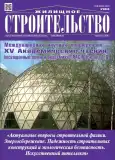Changes in the Characteristics of the Heating Period in Moscow Due to Global Climate Warming
- Authors: Gorbarenko E.V.1,2, Gagarin V.G.3,2,4, Korkina E.V.2,4
-
Affiliations:
- Lomonosov Moscow State University
- Scientific-Research Institute of Building Physics of RAACS
- Scientific Research Institute of Mechanics Lomonosov Moscow State University
- National Research Moscow State University of Civil Engineering
- Issue: No 6 (2024)
- Pages: 25-31
- Section: Articles
- URL: https://modernonco.orscience.ru/0044-4472/article/view/634821
- DOI: https://doi.org/10.31659/0044-4472-2024-6-25-31
- ID: 634821
Cite item
Abstract
Currently, one of the main problems of the world community has become the problem of climate change on Earth, global warming has been recorded. On the territory of the Russian Federation, the average surface air temperature rises at a rate of 0.43оC per decade, which is more than two and a half times the rate of global warming and is recorded mainly in the winter and spring seasons. Important applied parameters of the cold season are the climatic characteristics of the heating period. Its duration and average temperature are the main indicators in estimates of energy costs for heating buildings. Reducing the average duration and increasing the temperature of the heating period create conditions for reducing the consumption of thermal energy. The reduction of energy costs during the heating period refers to the possible positive consequences for the Russian Federation of the expected climate changes, which have a significant potential for effective sectoral and regional economic development. For the rational use of climate change, it is necessary to take them into account in building codes. In the presented work, based on 60 years of observations by the Meteorological Observatory of the Faculty of Geography of Moscow State University, the variability of the main characteristics of the heating period in Moscow is analyzed. It is shown that there is a tendency to decrease the degree-day of the heating period, although there are years when the main characteristics of the heating period advise the climatic norm of earlier observations.
Full Text
About the authors
E. V. Gorbarenko
Lomonosov Moscow State University; Scientific-Research Institute of Building Physics of RAACS
Author for correspondence.
Email: Elena.V.Korkina@gmail.com
Candidate of Sciences (Geography)
Russian Federation, 1, Leninskie Gory, Moscow, 119991; 21, Lokomotivniy Driveway, Moscow, 127238V. G. Gagarin
Scientific Research Institute of Mechanics Lomonosov Moscow State University; Scientific-Research Institute of Building Physics of RAACS; National Research Moscow State University of Civil Engineering
Email: gagarinvg@yandex.ru
Doctor of Sciences (Engineering), Professor, Corresponding member of RAACS
Russian Federation, 1, Leninskie Gory, Moscow, 119991; 21, Lokomotivniy Driveway, Moscow, 127238; 26, Yaroslavskoe Highway, Moscow, 129337E. V. Korkina
Scientific-Research Institute of Building Physics of RAACS; National Research Moscow State University of Civil Engineering
Email: elena.v.korkina@gmail.com
Candidate of Sciences (Engineering)
Russian Federation, 21, Lokomotivniy Driveway, Moscow, 127238; 26, Yaroslavskoe Highway, Moscow, 129337References
- Eames M., Dixon T., May T., Hunt M. City futures: Exploring urban retrofit and sustainable transitions. Building Research and Information. 2013. No. 41, pp. 504-516. DOI: https://doi.org/10.1080/09613218.2013.805063
- Yunsong Han, Hong Yu, Cheng Sun. Simulation-based multiobjective optimization of timber-glass residential buildings in severe cold regions. Sustainability. 2017. Vol. 9 (12). 2353. DOI: https://doi.org/10.3390/su9122353
- Vtoroj ocenochnyj doklad Rosgidrometa ob izmeneniyah klimata i ih posledstviyah na territorii Rossijskoj Federacii [The second assessment report of Roshydromet on climate change and its consequences on the territory of the Russian Federation]. Moscow: Rosgidromet. 2014. 58 p.
- Korkina E.V., Shmarov I.A., Tyulenev M.D. Effectiveness of energy-saving glazing in various climatic zones of Russia. IOP Conference Series: Materials Science and Engineering. 2020. Vol. 869 (7), pp. 072010. DOI: https://doi.org/10.1088/1757-899X/869/7/072010
- Ying Zi , Cheng Sun, Yunsong Han. Sky type classification in Harbin during winter. Journal of Asian Architecture and Building Engineering. 2020. Vol. 19 (5), pp. 515–526. DOI: https://doi.org/10.1080/13467581.2020.1752217
- Gagarin V.G., Zhibo Ch. Accounting for the degree-day heating period when comparing energy consumption by buildings. BST: Byulleten’ stroitel’noj tekhniki. 2016. No. 6 (982), pp. 58–59. (In Russian).
- Dvoreczkij A.T., Spiridonov A.V., Shubin I.L. Nizkoenergeticheskie zdaniya: okna, fasady, solncezashhita, energoeffektivnost’ [Low energy buildings: windows, facades, sun protection, energy efficiency]. Moscow: Direkt-Media. 2022. 232 p.
- Kontoleon K.J. Dynamic thermal circuit modeling with distribution of internal solar radiation on varying façade orientations. Energy and Buildings. 2012. Vol. 47 (4), pp. 139–150.
- Ocenochnyj doklad ob izmeneniyah klimata i ih posledstviyah na territorii Rossijskoj Federacii. Obshchee rezyume [Assessment report on climate change and its consequences on the territory of the Russian Federation. General summary]. Ed. by T.V. Leshkevich. Moscow: MGU. 2008. 29 p. (In Russian). https://doi.org/10.1016/j.enbuild.2011.11.037
- Malyavina E.G., Frolova A.A. The choice of economically feasible thermal protection of buildings in the North of the Russian Federation. Zhilishchnoe Stroitel’stvo [Housing Constructions]. 2022. No. 12, pp. 72–78. (In Russian). DOI: https://doi.org/10.31659/0044-4472-2022-12-72-78
- Samarin O.D. On the reasonable definition of the boundaries of the heating season. Zhilishchnoe Stroitel’stvo [Housing Constructions]. 2017. No. 1–2, pp. 33–35. (In Russian).
- Korkina E.V., Gorbarenko E.V., Gagarin V.G., Shma- rov I.A. Basic ratios for calculating solar radiation exposure to the walls of detached buildings. Zhilishchnoe Stroitel’stvo [Housing Constructions]. 2017. No. 6, pp. 27–33. (In Russian).
- Klimat Rossii [The climate of Russia]. Ed. by N.V. Kobysheva. Saint Petersburg: Hydrometeoizdat. 2001. 655 p. (In Russian).
- Spravochnik ekologo-klimaticheskix xarakteristik Moskvy. Pod red. A. A. Isaeva [Handbook of Ecological and Climatic Characteristics of Moscow. Ed. by A.A. Isaev]. Moscow: MSU. 2005. Vol.2. 409 p.
- Gorbarenko E.V. Radiation climate of Moscow. Meteorologiya i gidrologiya. 2020. No. 7, pp. 36–49. (In Russian).
- Klimat Moskvy v usloviyah global’nogo potepleniya [The climate of Moscow in the context of global warming]. Ed. by A.V. Kislov. Moscow: MGU. 2017. 288 p.
- Perevedentsev Yu.P., Gimranova A.B., Sharipova M.M., Aukhadeev T.R. Modern changes in climatic characteristics of the heating period in Kazan. Uchenye zapiski Kazanskogo universiteta. 2014. Vol. 156, pp. 123–130. (In Russian).
- Shchelokov Ya.M. On the climatic parameters of heating periods. Novosti teplosnabzheniya. 2006. No. 5 (69). (In Russian).
Supplementary files








